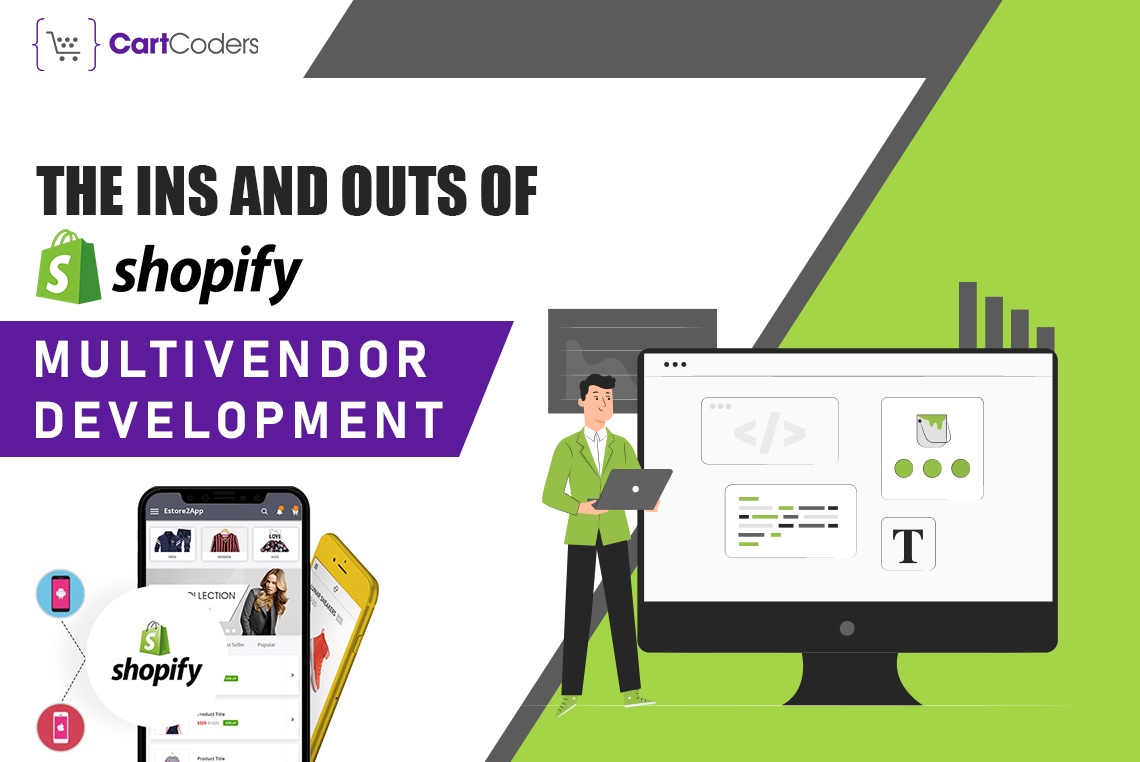Shopify Multivendor is one of the best platforms out there to build an online marketplace. This article provides a comprehensive guide for developers on getting started with Shopify Multivendor development.
By the end of this, you’ll be equipped with the knowledge and resources to create Shopify Multivendor stores for your clients and help them launch successful marketplaces. So, let’s start navigating this space in detail.
What Is Shopify Multivendor Development?

Shopify Multivendor development allows multiple vendors to sell on a single Shopify store. As the store owner, you handle payments, shipping, and customer service, while vendors handle adding and managing their own products. It’s an easy way for vendors of all sizes to start selling online without the hassle of setting up their own store.
To get started, you’ll work with a Shopify expert who can:
· Set up the Multivendor app and configure your store to allow multiple vendors.
· Create vendor accounts and profiles where vendors can add products, update inventory, view reports, and more.
· Build a product template so all products have a consistent look and feel.
· Set commissions and payout schedules so you and your vendors get paid on time.
· Provide vendor training to get all your vendors up and running.
A good Shopify Multivendor developer will guide you through the entire setup process and ensure your store is optimized to attract both vendors and customers. They’ll have experience building and optimizing high-converting Multivendor stores for clients in various industries. Ideally, they’ll also provide ongoing support to help your business scale.
If you want to start a profitable Multivendor marketplace, partnering with a Shopify Multivendor development company like CartCoders is key. They have the expertise to build you a store that runs smoothly and keeps both vendors and customers happy. Why try to figure it out yourself when the pros can do it even better? A well-crafted Multivendor store is an investment that will pay off big time.
Why You Should Consider Shopify Multivendor Development Services
If you’re looking to start an online marketplace, Shopify Multivendor development services are the way to go. Here are some compelling reasons to choose it:
· It’s easy to use: Both the admin and the storefront are simple to navigate. You don’t need any coding experience to get started, though developers will love the API and Liquid templating language.
· It’s customizable: You can choose from thousands of free and paid themes, sections, and apps to tailor your site.
· It’s scalable: Shopify Multivendor stores are built to scale. As your business grows, the platform seamlessly handles more products, orders, and vendors. You’ll never outgrow your store.
· It offers valuable features: Some useful features include inventory management, shipping, fulfillment, payment processing, marketing, analytics, and channel integrations. Everything you need to operate a successful online marketplace.
· Expert support is available: Shopify has a large network of partners that offer Shopify Multivendor development services. They can help you design, develop and promote your store to maximize its potential.
Key Features of a Shopify Multivendor Store

A Shopify Multivendor store has some key features that set it apart from a standard Shopify store. A few are mentioned below:
1.Separate vendor profiles and storefronts
Each vendor gets their own customizable profile and mini-store within your Shopify Multivendor store. They can upload their own logo, banner images, and product listings. Customers can view all products from a single vendor on their storefront.
2. Vendor-level permissions
You have full control over what each vendor can do in the admin. You can restrict capabilities like adding blog posts, editing navigation menus or viewing reports. Set different permission levels for vendors and administrators.
3. Commission rates
Charge vendors a commission on each of their sales. Set a flat rate or percentage, and commissions are automatically deducted with each order. Vendors can view their commission statements and payout details in the admin.
4. Marketing and SEO tools
Vendors have access to marketing tools like discount codes, blog posts, and email marketing campaigns. Their products and content are also indexed in your store’s search and benefit from your SEO efforts.
5. Order management
Vendors are notified when they receive an order and can fulfill and track the shipping of their own orders. They are only able to view and manage orders for their own products.
6. Payouts
Issue payouts to vendors on the scheduled time chosen by you. Payouts can be done manually or automatically based on vendor requests. Vendors must meet a minimum payout amount, which you configure.
A Shopify Multivendor store transforms a standard Shopify store into a full-fledged marketplace. With the right set of features and vendor permissions, you can build a platform for vendors to sell their goods and services at scale.
Carefully consider how you want to structure commissions, payouts, marketing opportunities and other parameters to keep both customers and vendors happy.
How to Create a Shopify Multivendor Store
Here are a few key steps to get started:
1.Choose a theme
The first thing you’ll need to do is pick a theme for your store. Shopify offers a number of free and paid multivendor-ready themes to choose from. Some options include:
Multivendor Marketplace Theme — A free theme great for a variety of multivendor stores. Includes product reviews, storefronts for vendors, and more.
Vendina Theme — A stylish paid theme with a focus on fashion and clothing. Features vendor profiles, storefronts and product promotions.
Startup Theme — An affordable paid theme suited for handmade goods, vintage items and crafts. Includes vendor profiles, collections and custom forms for vendors.
2. Set up the app
Next, you’ll want to install the Shopify Multivendor App. This free app allows multiple vendors to sell products on your store. Each vendor gets their own standalone storefront to upload products, run sales and more. As the store owner, you have full control over commissions, payouts, and what vendors can do.
3. Recruit vendors
With your theme and app set up, it’s time to find vendors for your store. Reach out to makers, artists, manufacturers and wholesalers to see if they’re interested in selling their goods on your multivendor store. Be prepared to share details about fees, available features and how you’ll drive traffic and sales to their products.
4. Manage the store
As orders come in, the app will automatically calculate any commissions you set and keep track of balances for payouts to vendors. You’ll want to monitor the store to ensure high quality products, solid reviews, and a good experience for customers. Make any changes needed to themes, apps or policies to keep improving your Shopify Multivendor store.
With some initial setup and by finding great vendors, you’ll be running your own profitable Shopify Multivendor business in no time.


No comments yet